The Federal Reserve’s dual mandate requires it to focus on encouraging economic growth and managing inflation levels. How does the Fed know when there’s a problem requiring action? Economists constantly keep track of various indicators, data sets, and factors. We’ll cover the following in this chapter:
Economic growth is generally measured by gross domestic product (GDP) or gross national product (GNP). GDP measures all goods and services produced within the country’s borders and is commonly utilized by economists to measure economic strength. GNP measures all goods and services produced by residents of a country, including those made outside of the country (e.g., goods sold by a US citizen while they temporarily live in Spain). GDP and GNP are measured in constant dollars, meaning the reported data are inflation-adjusted. That way, economists can compare the economic output of different periods easily.
If GDP rises, more goods and services are being created and sold in the United States, resulting in economic growth. The higher it rises, the faster the economy is growing. If GDP falls, fewer goods and services are being created and sold, resulting in economic distress. When this occurs for long periods, the economy can fall into a recession or depression. A recession is two consecutive quarters (six months) of GDP decline, while a depression is six straight quarters (a year and a half) of GDP decline.
The Fed pursues loosening (expanding) policies when GDP declines, aiming to increase the money supply. Interest rates fall, leading consumers to purchase more homes, cars, and other goods. As a reminder, the Fed would perform one or more of the following actions if the economy was shrinking:
The Federal Reserve follows the consumer price index (CPI) to gauge inflation levels. Every month, the US Bureau of Labor Statistics tracks the prices of goods and services used by everyday people, including gasoline, groceries, cell phone contracts, and real estate. If prices increase on average, CPI rises (and vice versa).
When CPI levels rise more than expected, the Fed pays close attention. Remember, inflation could be a result of their loosening policies. If the Fed puts too much money in the money supply, it will likely lead to higher inflation. When this occurs, the Fed will institute one or more of the following tightening (contracting) policies to reduce and manage inflation:
With these actions, the Fed reduces the money supply, leading to higher interest rates. Money is like any other good; the less that exists, the more expensive it is to borrow. Higher interest rates lead to fewer goods and services purchased, eventually stabilizing prices.
Federal Reserve actions heavily influence the bond market. One way to track changing dynamics is through yield curves, which display yields of similar debt securities across multiple maturities. For example:
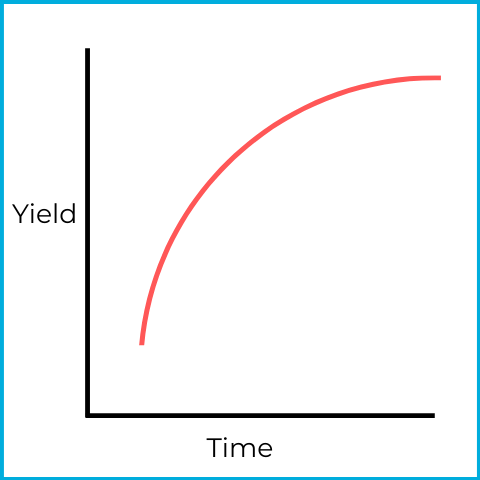
This is a normal (ascending) yield curve. As the name suggests, it is a standard yield curve. Securities with shorter maturities maintain lower yields, while longer maturities reflect higher yields. As we already know, more time means more risk exposure.
Sometimes, the yield curve displays a unique bond environment. For example:
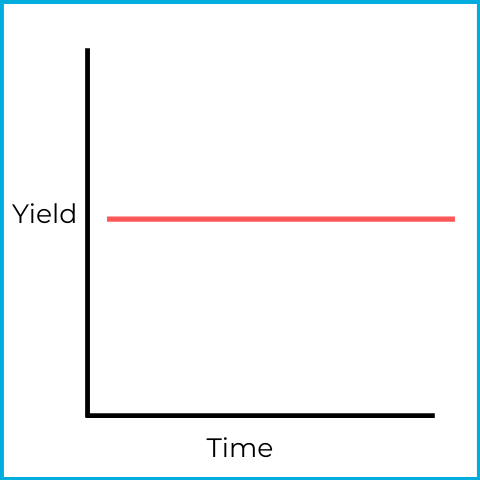
This is a flat yield curve, indicating uncertainty in the bond market. Short-term debt securities yield the same as long-term debt securities, which is atypical. Investors may be liquidating their short-term debt securities and buying long-term bonds. Less demand for short-term securities leads to lower prices and higher yields, while more demand for long-term securities leads to higher prices and lower yields. The combined actions would result in a flattened yield curve.
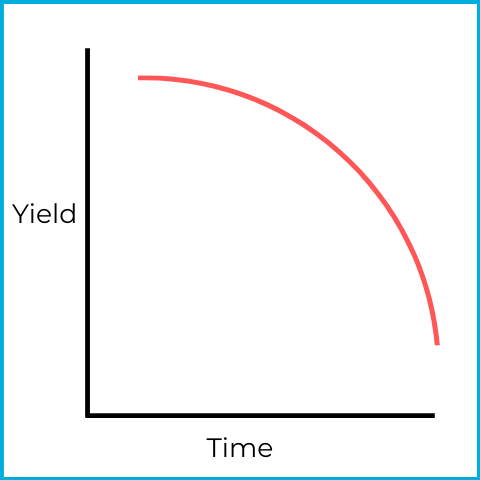
This is an inverted (descending) yield curve, indicating a pending economic recession. Short-term debt securities maintain higher yields than long-term debt securities. An inverted yield curve is a continuation of the factors leading to a flat yield curve (flat occurs first, then it inverts). Investors liquidate their short-term debt securities and buy long-term bonds if a recession is expected.
Why does this occur? You already know the Federal Reserve does everything it can to lower interest rates when the economy is in recession. When investors see signs of an economic downturn, they’ll move their money from short-term debt securities to long-term bonds to lock in high coupons (interest rates). If they can do it fast enough, they’ll obtain bonds with higher rates of return for long periods while interest rates decline. Additionally, bond prices rise when interest rates fall, providing capital appreciation (gain) potential.
Investors can find yield curves of all kinds, including those covering the entire bond market or specific securities (corporate, municipal, US Government, etc.). There are also comparative yield curves, sometimes called credit yield spreads, that juxtapose two different sets of yield curves. In particular, investors forecast economic activity by comparing US government and corporate yield curves.
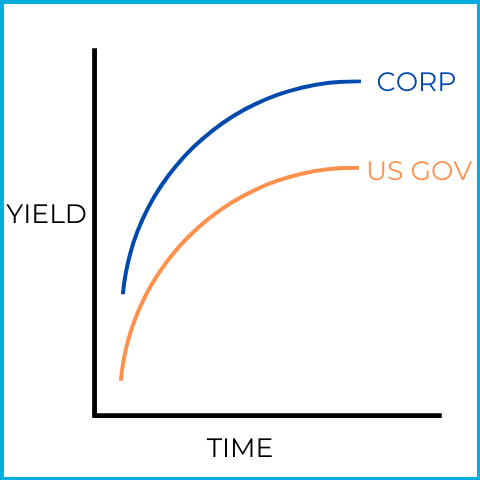
Corporate debt securities maintain higher yields than US Government securities, primarily due to the risk involved. Comparative yield curves measure the distance between the two yield curves.
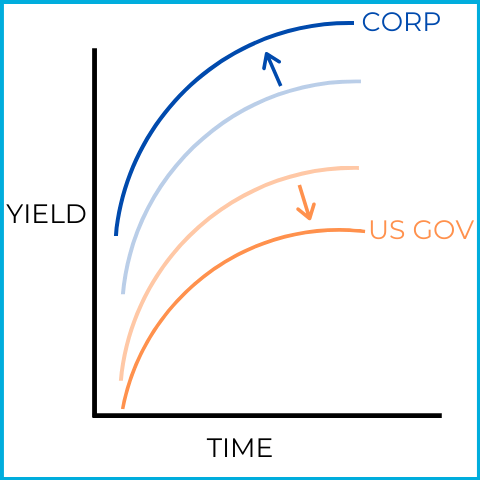
In this picture, the yield curves widen (go further apart), signaling an economic recession. Investors are liquidating their riskier corporate investments and buying safer US government securities. The decreased demand for corporate bonds drives down prices and raises yields. The increased demand for US government bonds drives up prices and lowers yields. Investors are shifting their portfolios to safer investments (out of corporate and into government securities) to protect themselves. That’s why a widening yield curve is a sign of an upcoming recession.
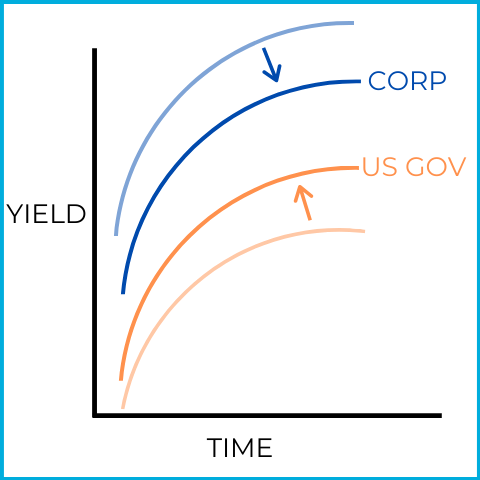
In this picture, the yield curves narrow and get closer, signaling economic prosperity (expansion). Investors are liquidating their safer US government bonds and buying riskier corporate bonds. The increased demand for corporate securities drives up prices and lowers yields. The decreased demand for US Government bonds drives down prices and raises yields. Investors are shifting their portfolios to riskier investments (out of government and into corporate securities) because they’re confident in the economy and willing to take more risk. That’s why a narrowing yield curve is a sign of economic prosperity.
Economists consider certain economic indicators to be leading, predicting where the economy is headed. These are the most common leading indicators utilized by economists:
All of these items have a history of predicting changes in the economy. The S&P 500, for example, began experiencing accelerating declines towards the end of the summer of 2007. According to the US National Bureau of Economic Research, the Great Recession didn’t begin until December 2007, and wasn’t a significant economic problem until mid-2008. That’s why some economists refer to the S&P 500 as a six-month future (leading) economic predictor.
The forecasting nature of some indicators should be intuitive. Average weekly initial claims for unemployment detail the number of people just losing their jobs. Once unemployed, people tend to spend less on goods and services (until they’re re-employed). When a mass of people reports unemployment at once, it’s likely to lead to quick GDP declines. The same concept applies to indicators involving new goods orders or building permits.
The consumer confidence index measures people’s general optimism regarding the economy. The more confident the average consumer is, the more likely they’ll spend their money (and vice versa).
The interest rate spread between the 10-year Treasury note and the federal funds rate is a good predictor of economic declines. In particular, when Treasury note interest rates fall below the federal funds rate, it indicates an upcoming recession. Don’t worry too much about interpreting this indicator; test questions typically focus on the fact that it’s a leading indicator (and not much else).
A coincident indicator provides some insight into the economy’s current strength. They include:
Don’t put too much effort into knowing what these indicators cover. Test questions typically focus on how they inform us about the current economic strength.
A lagging indicator provides insight into the economy’s past performance. The most commonly cited lagging indicators include:
*Keep in mind the differences between initial unemployment claims (a leading indicator), the unemployment rate (a coincident indicator), and the average duration of unemployment (a lagging indicator). Don’t worry too much about analyzing them - just know which is leading, coincident, and lagging. Test writers are known to pick on similar topics (e.g., the various ways to measure unemployment) to determine if you understand the differences.
Economic market structures can have a significant impact on the dynamics of an economy. These structures can exist in a particular part of the economy (e.g., in the pharmaceutical sector) or across the entire economy. You may encounter some test questions on the basics of these four structures:
Perfect competition
This market structure involves many buyers and sellers of virtually identical products. No “big” players dominate the market with the power to influence prices upward or downward. A typical example is a farmer’s market. The vendors offer the same products (e.g., fruits and vegetables), and their prices are the primary factor determining demand (the farmer with the cheapest goods gets the most business).
Monopolistic competition
Like perfect competition, monopolistic competition involves many buyers and sellers. However, the products competing with one another can be differentiated from one another. For example, think about the last time you strolled down the chips aisle at your grocery store. You probably could find Doritos, Lays, Ruffles, Sun Chips, etc. In this market structure, the chip vendors all compete, but consumer demand is not strictly price related, but driven by other factors such as unique features one chip has over another. But, in a perfect competition structure, walking down the apple aisle, if you saw three identical bins of red apples, you’d choose the one with the lowest price. In monopolistic competition, if one vendor attempted to manipulate the price (attempting to drive the prices of all chips up or down), it would likely not work due to the large number of products or services available.
Oligopoly
An oligopoly market structure involves many buyers but a limited amount of sellers (typically 3-5). The limited number of vendors is generally due to a considerable market entry cost. The airline industry is a good example. American, Southwest, Delta, and United Airlines represent roughly 70% of the industry. Imagine how difficult and costly it is to start an airline business to compete with the four major carriers. Because of the limited number of vendors, price manipulation (of their goods and services) is easier.
Monopoly
Monopolies involve many different buyers, but only one seller dominates the market. While government regulations are in place to prevent monopolies, some still exist. For example, utility companies typically maintain monopolies in their local areas. In most cities, people obtain electricity from only one company or government-sponsored organization. Price manipulation is very easy because monopolies have no competition; this is why the utility sector is highly regulated.
Sign up for free to take 19 quiz questions on this topic